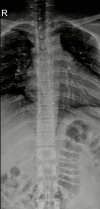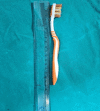Accidental Toothbrush Ingestion
- PMID: 39050279
- PMCID: PMC11265967
- DOI: 10.7759/cureus.62955
Accidental Toothbrush Ingestion
Abstract
The accidental ingestion of a toothbrush is an extremely rare occurrence, typically involving young women with psychiatric disorders such as schizophrenia, bulimia, or anorexia nervosa. There are no known cases of a swallowed toothbrush being expelled naturally through the rectum. Therefore, prompt extraction of an ingested toothbrush from the gastrointestinal tract using a surgical or endoscopic method is a necessity. Here, we report a case of a psychologically healthy woman ingesting a toothbrush accidentally while cleaning her tongue with the back of the toothbrush. In our report, we document the successful extraction of a toothbrush from the esophagus endoscopically without any complications.
Keywords: accidental ingestion; endoscopy; gastroenterology; gastrointestinal foreign body; toothbrush.
Copyright © 2024, Karad et al.
Conflict of interest statement
Human subjects: Consent was obtained or waived by all participants in this study. Conflicts of interest: In compliance with the ICMJE uniform disclosure form, all authors declare the following: Payment/services info: All authors have declared that no financial support was received from any organization for the submitted work. Financial relationships: All authors have declared that they have no financial relationships at present or within the previous three years with any organizations that might have an interest in the submitted work. Other relationships: All authors have declared that there are no other relationships or activities that could appear to have influenced the submitted work.
Figures
References
-
- Gastrointestinal foreign bodies. Chen MK, Beierle EA. Pediatr Ann. 2001;30:736–742. - PubMed
-
- Foreign bodies of the upper gastrointestinal tract: current management. Webb WA, McDaniel L, Jones L. South Med J. 1984;77:1083–1086. - PubMed
-
- Removal of blunt foreign bodies from the esophagus. Hawkins DB. Ann Otol Rhinol Laryngol. 1990;99:935–940. - PubMed
-
- Toothbrush swallowing. Kirk AD, Bowers BA, Moylan JA, Meyers WC. Arch Surg. 1988;123:382–384. - PubMed
-
- Ingested foreign bodies of the gastrointestinal tract: retrospective analysis of 542 cases. Velitchkov NG, Grigorov GI, Losanoff JE, Kjossev KT. World J Surg. 1996;20:1001–1005. - PubMed
Publication types
LinkOut - more resources
Full Text Sources




